What’s Here
Welcome to my collection of third grade classroom photos! This page features photos of a classroom in Prince George’s County, Maryland (just outside of Washington, D.C.) Though I started teaching in 1999, I first had access to a digital camera in 2003, so the classroom tours unfortunately don’t start until later! 2003 was also the year I created the classroom management website that The Cornerstone evolved from. I’ve kept the text on this page exactly the same as when I first uploaded the pictures to my website so that it feels like you’ve just walked into my room and are taking a tour!
Classroom Pictures
The photos and captions from 2003 were accidently deleted when I changed webhosts in 2004, and unfortunately were completely irretrievable. The following are pictures I was able to scrounge up from other places on the ‘net where they were posted.
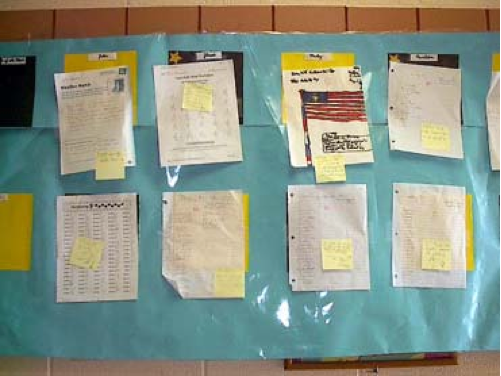
Here is our year-round bulletin board hanging in the hallway. Each child has one section and is responsible for selecting from his or her Friday Folder the paper that child is most proud of. The students write on a sticky note why they are so proud of their papers, and hang them up on the way out to the bus on Friday afternoon. This bulletin board changes weekly, requires about five minutes on the part of each child every Friday afternoon, and requires no work at all from the teacher, apart from the initial set up.
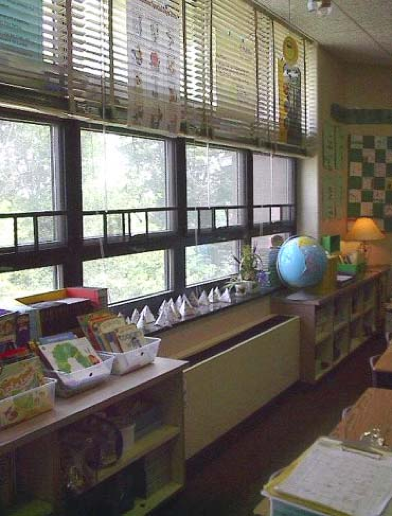
Here’s the window side of the room. On the left are dictionaries and other books for students, along with their book bins (the books are pre-distributed, and kids keep the same one for a week then rotate). I keep math manipulatives on the shelf underneath. I hung yarn from the top of the blinds and hang posters from clothespins attached to the yarn. This took about an hour to do for 5 windows, but was worth it. If you attach posters directly to the blinds, you can’t open and close the blinds. This way, you can.
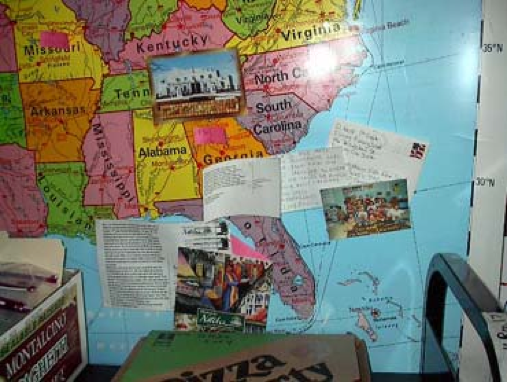
We participated in a Postcard Exchange project this year! It seemed like it would be a cool idea, because each child chose a state and marked it on the map with a signed sticky note, then wrote to a school in that state (we arranged this through the web). When we got postcards back, I photocopied the back and hung both the picture side and letter side on the map. I would not recommend this project, though, because we got very few postcards back. The kids were very disappointed, and suggested that next year, my class should just exchange with one school to make sure that we got letters. I like that idea and am currently searching for another third grade class willing to exchange letters monthly. I may even do it with another school in our county because we can send the letters for free through inter-county mail. Another teacher did this and had great success–she felt that the kids really had a lot in common and related well to each other because of their proximity.
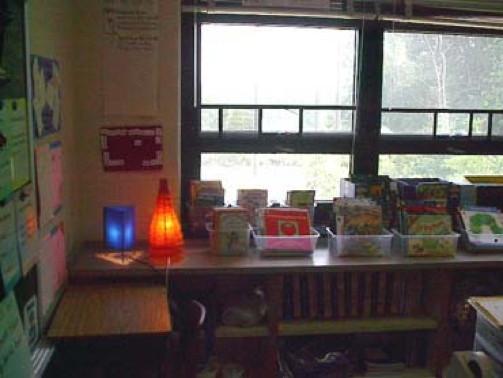
I use lamps everywhere and as much natural light as possible. I only turn on the overhead florescent lights if it’s a very dark and rainy day, and they kids groan whenever I do! It is much more relaxing and homey without that harsh light. Most of my lamps cost less than $10 and some were less than $5 (from Ikea). Above the orange and blue lamps in the picture you can see my seating chart. I rearrange desks constantly, and the easiest way to plan it out is to write each child’s name on a piece of index card cut into a small rectangular desk shape, and hook Velcro on the back. I move the ‘desks’ around on a scrap of felt, and when I feel like I’ve got a good arrangement, I hang it up.
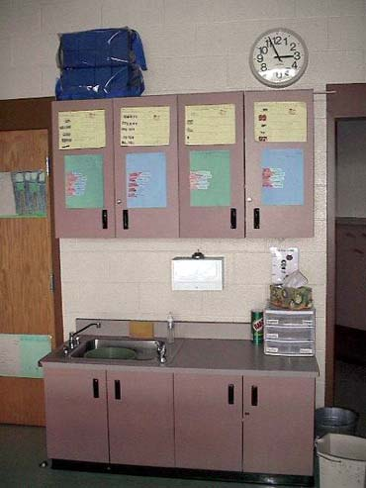
We are fortunate to have sinks with water fountains in our rooms! Students may get drinks 3 times a day from the classroom water fountain: when they arrive at school, after recess, and at the end of the day. (Of course, they also have milk or juice at breakfast and lunch). All students receive free breakfast each day through a grant from the Maryland Schools for Achievement. The little organizer you see in the picture holds our spoons, napkins, straws, etc. Students take their own breakfast supplies and are responsible for clean up, as well. Lunch is served in the cafeteria.
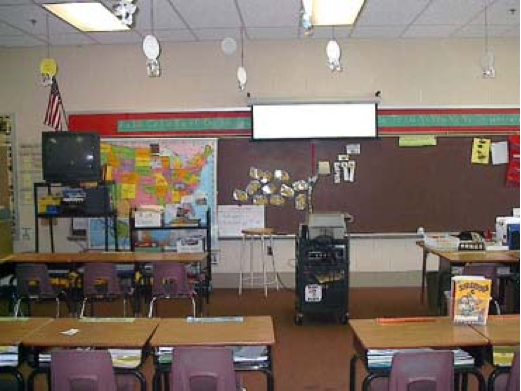
This is the front of the room view, what the students see most of the time. At the top right side of the board, you’ll see a little lime green sign at the top of the board says ‘Independent Work–You may go to the bathroom without asking’. The other side is red and says ‘I’m Teaching. Please do not go or ask to go to the bathroom’. I used this a lot in the beginning of the year when I was still training the students to understand appropriate and inappropriate times to go, but now I usually leave it on green. I don’t require my students to ask before using the bathroom, but since so many teachers do, the kids ask a lot in the beginning of the year and really aren’t able to monitor when they shouldn’t get up (such as when test directions are being given or buses are being called). The sign helps a lot with this.
There is also a desk next to the bathroom door (not pictured here) which has the bathroom sign-in sheet on it. There are two columns, one for A.M. and one for P.M., and each student may sign in and use the bathroom twice a day. If they need to go more often, they can ask (the answer is always yes).
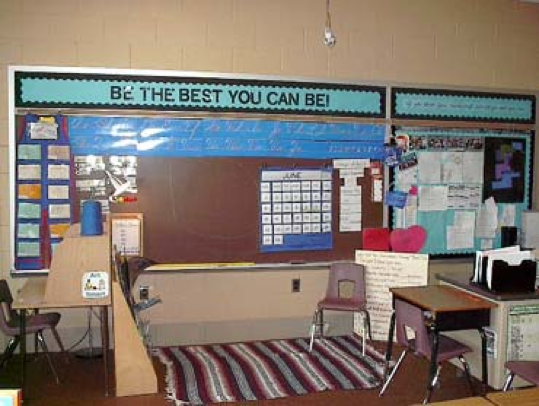
This is the back of the room. Student book clubs meet back here on the floor (the large chart has discussion tips, etc. on it). I also teach small group instruction for math back here–when an independent assignment was given, if student still did not feel like they didn’t ‘got it’, they can sit in the back of the room and I work a few more problems with them on the board. They think this is a lot of fun, for some reason! You can also see one of the signs for my language arts centers. They are based on Howard Gardner’s Multiple Intelligences. There is one on the side of my desk by the child-size desk, but the one you can most easily see here is “Art Smart”. Each intelligence is renamed into kid language (Art Smart is supposed to be visual- spatial intelligence). I got the signs from abcteach.com for free. I then made a center (or two, or three) for each intelligence as it related to language arts (spelling, word making, reading, writing, and so on). The kids love them and the centers only need ‘updating’ twice each school year (mostly adding more paper or photocopies to each one). Each center has a specific location in the room in which it should be used (although I keep the centers altogether in a file box in the reading area). Having designated areas to complete each center ensures that students are spread out and not in places that would interfere with small groups or independent work.
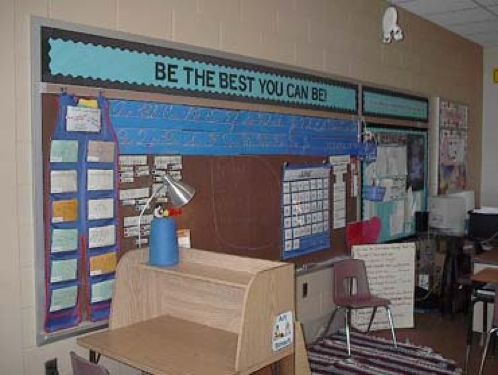
On the far left is an overall-shaped pocket chart with various graphic organizers and book response prompts I created on index cards. Students often select from these for various assignments, copy the organizer into their journals, and then return the index card to the pocket chart. Next to the pocket chart are our reading rotation magnets. I created them so that each child would know whether to go to small group, book club, independent work, or S.S.R. (Sustained Silent Reading) during each rotation, but I found that with third graders, this really is not necessary. After awhile, I just called out the rotations and the names of the students who would be in each place, and they did well with that. I kept track on my clipboard instead. This was important because I don’t have fixed reading groups—they are flexible groups that change with the skill. Some kids are fluent readers but don’t comprehend; some lack phonics skills but have great expression, and so on, so I don’t think rigid groupings fit their needs. I also like mixing up the kids because that way no one feels like they are in the ‘slow’ or ‘fast’ group.
More of My Classroom Tours
 Classroom Photos After 2009
Classroom Photos After 2009
Classroom Photos 2009
Classroom Photos 2008
Classroom Photos 2007
Classroom Photos 2006
Classroom Photos 2005
Classroom Photos 2004
Classroom Photos Before 2003
Check Out Other Teachers’ Classroom Photos
Want to see photos of Other Teachers’ Rooms? I’ve collected classroom pictures from educators in all different parts of the United States! Learn their tips for desk arrangement, organization, and more.
Please Share YOUR Classroom Photos!
Would you like to have your pictures featured here? I’d love to add your classroom pics to the Other Teachers’ Rooms page! Contact me via email with the link to your Flickr, Tumblr, Picassa, blog, Pinterest board, or even a public Facebook album! Don’t worry about making sure everything looks perfect: we want to see REAL classrooms that are used by REAL students every day! International teachers–we’d especially love to see what your rooms look like!
Now What?
Get tips for decorating your space on the Creating a Cozy Classroom page
Check out the ideas for using your wall space on the Bulletin Board Solutions page
Learn how to set up your rug/carpet area on the Class Meetings page
Discover how to create workstations around your classroom on the Setting Up Centers/Stations page

Angela Watson
Founder and Writer
OR

Join our
community
of educators
If you are a teacher who is interested in contributing to the Truth for Teachers website, please click here for more information.















